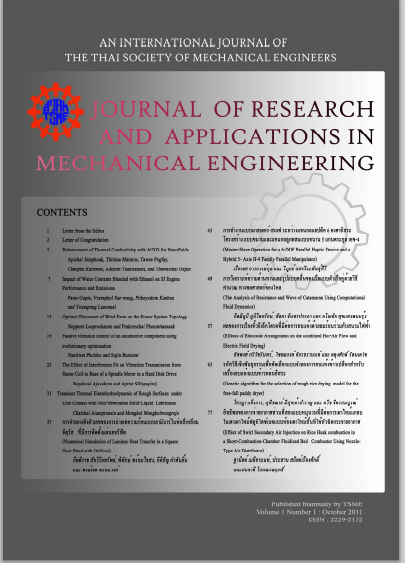The effect of baffles on fluid sloshing inside the moving rectangular tank
Main Article Content
Abstract
Sloshing of fluid inside a container such as tanker trucks is the important phenomenon that develops pressure on tank wall which can cause structural damage or loss of the maneuvering stability. Decreasing the severe sloshing, the baffles are required to be included into the tank at appropriate locations. The FVM (Finite Volume Method) is the favorite method for analyzing the fluid sloshing. The effect of baffles on the fluid sloshing can be investigated using the computational models. This research improved C++ code of the fluid sloshing inside the movable tanks with and without baffles. These codes were implemented in the Open Source software that was the OpenFOAM. The computational results were validated with the experiment results which had a good correlation. The different results between simulation and experiment were digitized using the image processing techniques and had the average error less than 3.73%. This error can be proved that the computational method can be used to evaluate the effects of the baffles to control the sloshing of fluid inside the tanker trucks.
Article Details
This work is licensed under a Creative Commons Attribution-NonCommercial-ShareAlike 4.0 International License.
References
[2] Liu, D. and Lin, P. (2008). A numerical study of three-dimensional liquid sloshing in tanks, Journal of Computational Physics, vol. 227, December 2007,pp. 3921-3939.
[3] Cho, J.R., Lee, H.W. and Ha, S.Y. (2005). Finite element analysis of resonant sloshing response in 2-D baffled tank, Journal of Sound and vibration, vol. 288, April 2005, pp. 829-845.
[4] Eswaran, M., Saha U.K. and Maity, D. (2009). Effect of baffles on a partially filled cubic tank: Numerical simulation and experimental validation, Computers and Structures, vol. 87, December 2008, pp. 198-205.
[5] Rebouillant, S. and Liksonov, D. (2010). Fluidstructure interaction in partially filled liquid container: A comparative review of numerical approaches, Computers & Fluids, vol.39, January 2010, pp. 739-746.
[6] Threepopnartkul, K. and Suvanjumrat, C. (2010). Development and validation of a C++ object oriented CFD cods for two dimensional fluid sloshing simulations, paper presented in The 36th Congress on Science and Technology of Thailand, Bangkok, Thailand.
[7] Anderson Jr., J.D. (1995). Computational fluid Dynamics: The basics with applications, McGraw-Hill, New York.
[8] Hirt, C.W. and Nichols, B.D. (1981). Volume of fluid (VOF) method for the dynamics of free boundaries, Journal of Computational Physics, vol. 39, November 1979, pp. 201-225.
[9] Suvanjumrat, C. and Puttapitukporn, T. (2010). Sloshing surface monitoring using image processing, paper presented in The first TSME International Conference on Mechanical Engineering, Ubon Ratchathani,Thailand



